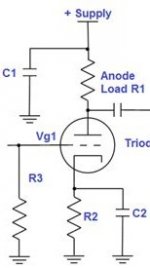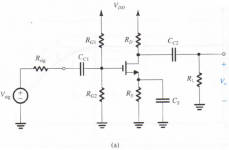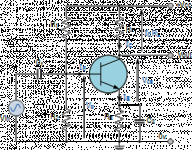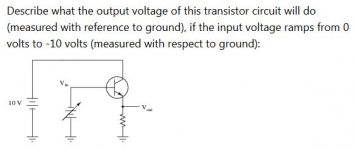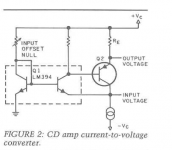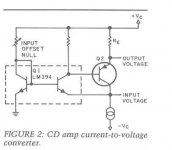Tubes, like JFETs, are depletion mode devices and can be self biasing. Common emitter and common cathode are analogous, in that both invert the signal along with voltage plus current gain being obtained.
FWIW, the current/voltage curves of FETs and pentodes are remarkably similar in appearance.
FWIW, the current/voltage curves of FETs and pentodes are remarkably similar in appearance.
Not sure if I have this right, but I think the confusion may stem from the compound use of the term 'Common'. It isn't that the cathodes or emitters are 'Common', it's that 'Common' is used as a term for 'AC Ground'.
When the designer says 'Common Cathode', he doesn't intend 'two cathodes connected in common'. S/He means 'the component terminal that provides the signal reference'.
So-o-o, the direct answer to AllenB's original question was, "Yes".
Sure hope I'm not in over my head!
Best Regards,
Rick
When the designer says 'Common Cathode', he doesn't intend 'two cathodes connected in common'. S/He means 'the component terminal that provides the signal reference'.
So-o-o, the direct answer to AllenB's original question was, "Yes".
Sure hope I'm not in over my head!
Best Regards,
Rick
Last edited:
Not sure if I have this right, but I think the confusion may stem from the compound use of the term 'Common'. It isn't that the cathodes or emitters are 'Common', it's that 'Common' is used as a term for 'AC Ground'.
When the designer says 'Common Cathode', he doesn't intend 'two cathodes connected in common'. S/He means 'the component terminal that provides the signal reference'.
So-o-o, the direct answer to AllenB's original question was, "Yes".
Sure hope I'm not in over my head!
Best Regards,
Rick
Fully agree, you nailed it Rick. Context is everything.
If there is a tube that has two sections that share a single cathode, you could say the two sections have a common cathode but obviously that is a different context thus has a completely different meaning.
Jan
Yes, context.
1. Start with:
A single tube (triode, tetrode, pentode, or beam power), a single bipolar transistor, a single JFET or MOSFET.
Then when the Cathode, Emitter, or Source (respectively) are Both part of the input signal and part of the output signal, that is a Common cathode, emitter, or source stage.
Example:
The signal is applied to a grid and the cathode (a signal that is from the grid to ground with the cathode at AC ground). The difference in voltage from the grid to the cathode is the input.
The output signal is from the plate to the cathode (the cathode is at AC ground, and the plate is connected to one end of an output transformer primary, the other end of the output transformer primary is connected to AC ground (power B+ filter cap to ground). The difference in voltage from the plate to the cathode is the output.
The cathode is the Common element for both input and output.
2. The 6J6 has 2 grids, 2 plates, and a single "common" cathode, pin 7. That is not the same as in # 1 above.
Apply two different audio signals (one to each grid), and use the single cathode as a cathode follower, and you have created a two channel Mixer.
By the way, that 'cathode follower' is also known as a 'common' plate amplifier, because to work properly, the plate(s) are at AC ground.
That is because the plate(s) are the common input element and output element. The grid and cathode move with signal, not the plate(s).
A single triode, 6J5, when used as a cathode follower is the same, but it is common plate, not common plate(s).
3. Both triodes of a 12AU7 are used in a phase splitter stage, with both cathodes, pins 3 and 8, wired together to a current sink.
That is not the same as #1 above, and is not the same as # 2 above.
I hope that made it un-commonly clear.
1. Start with:
A single tube (triode, tetrode, pentode, or beam power), a single bipolar transistor, a single JFET or MOSFET.
Then when the Cathode, Emitter, or Source (respectively) are Both part of the input signal and part of the output signal, that is a Common cathode, emitter, or source stage.
Example:
The signal is applied to a grid and the cathode (a signal that is from the grid to ground with the cathode at AC ground). The difference in voltage from the grid to the cathode is the input.
The output signal is from the plate to the cathode (the cathode is at AC ground, and the plate is connected to one end of an output transformer primary, the other end of the output transformer primary is connected to AC ground (power B+ filter cap to ground). The difference in voltage from the plate to the cathode is the output.
The cathode is the Common element for both input and output.
2. The 6J6 has 2 grids, 2 plates, and a single "common" cathode, pin 7. That is not the same as in # 1 above.
Apply two different audio signals (one to each grid), and use the single cathode as a cathode follower, and you have created a two channel Mixer.
By the way, that 'cathode follower' is also known as a 'common' plate amplifier, because to work properly, the plate(s) are at AC ground.
That is because the plate(s) are the common input element and output element. The grid and cathode move with signal, not the plate(s).
A single triode, 6J5, when used as a cathode follower is the same, but it is common plate, not common plate(s).
3. Both triodes of a 12AU7 are used in a phase splitter stage, with both cathodes, pins 3 and 8, wired together to a current sink.
That is not the same as #1 above, and is not the same as # 2 above.
I hope that made it un-commonly clear.
Last edited:
it's that 'Common' is used as a term for 'AC Ground'. S/He means 'the component terminal that provides the signal reference'.
Beautifully said.
The common emitter / source / cathode point of an LTP stage does not constitute a signal ground.
An LTP is an example of a cathode-coupled amp. I would not call it common cathode, as that simply creates confusion.
Unfortunately incorrect names sometimes acquire popularity, for example the so-called 'ground grid' amp which is actually an unbalanced cathode-coupled amp with (usually) no grid grounded. There is of course a genuine grounded-grid amp but that is rarely used in audio.
Unfortunately incorrect names sometimes acquire popularity, for example the so-called 'ground grid' amp which is actually an unbalanced cathode-coupled amp with (usually) no grid grounded. There is of course a genuine grounded-grid amp but that is rarely used in audio.
A grounded base transistor neither probably..There is of course a genuine grounded-grid amp but that is rarely used in audio.
Attachments
There was a studio mike-amp with grounded-base inputs. A little figuring got the input impedance "right" (a near match, in days when that was accepted). It performed well. It had the incidental advantage that when the mike was disconnected, gain went to zero, no "open cable" interference. AFAIK nobody copied it.
A common base transistor is a great I/V converter. Input current into E, output across a C-resistor. B is common reference.
I build something like that, ohh, 30 years ago? Worked great!
Jan
BTW Where it says 'input voltage' that should be, of course, 'input current'. Duh.
Jan
Attachments
it is a superior voltage amplifier at all.
Did you mean to say 'but it is not a superior ...'? That would make sense as it isn't a voltage amplifier, period.
Jan
...it isn't a voltage amplifier...
Grounded/Common-Base is a voltage amplifier. 30mV in will swing the collector to the rail. In general Vg is same as grounded emitter. At the extreme, a hair higher due to less modulation of the base area.
The current gain is 0.99 (versus 100+ for CE), and the input impedance is generally distressingly low.
BTW Where it says 'input voltage' that should be, of course, 'input current'. Duh.
This issue is conceptually too exacting.
Did you mean to say 'but it is not a superior ...'? That would make sense as it isn't a voltage amplifier, period.
What kind of amplifier is it in that case? Certainly not a current amplifier anyway.
It is superior to the grounded emitter amplifier from a distortion point of view. As a voltage amplifier, of course.
Why is that, because of the lacking C-B feedback? (see #11)
In short, because of low input impedance, uniform conductance, well-ordered internal phase relationships and drastically reduced Miller effect. Feedback cannot occur within a single device.
The middle transistor in post #12 is configured as grounded base amplifier. If it does not amplify voltage, the current to voltage conversion must have been brought forth by magic thirty years ago.
- Status
- This old topic is closed. If you want to reopen this topic, contact a moderator using the "Report Post" button.
- Home
- Amplifiers
- Tubes / Valves
- Is the term common cathode equivalent to common emitter?
